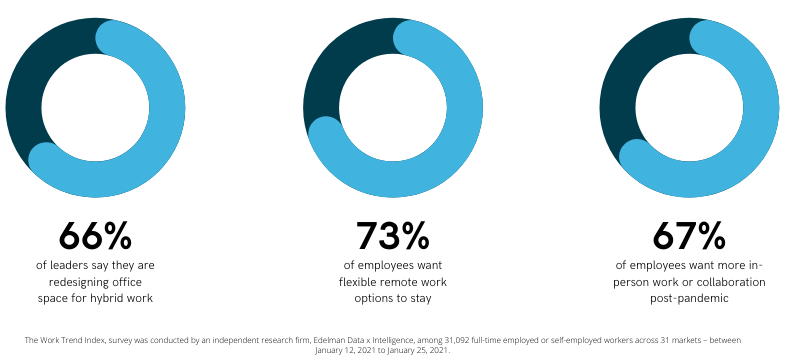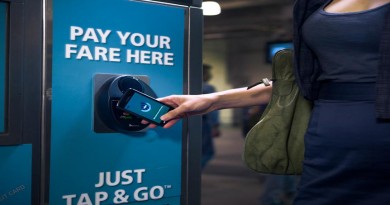Hybrid Working and the future of work post Pandemic
Hybrid working is a thing right? We’re now hopefully at the back end of a global pandemic which has caused restrictions on how folk work, and everyone has started thinking about whatever normal looks like & when normal will happen. Hopefully the constant discussions around COVID this or Omicron that are now starting to slow down for many.
Organisations want to show flexibility and build a hybrid working model that supports, accommodates & continues how people have worked over the last two years, whilst at the same time creating a pathway of getting people back together to use those expensive desk spaces currently taking up thin air & collecting dust.

Credit to: https://ms-worklab.azureedge.net/files/reports/hybridWork/pdf/2021_Microsoft_WTI_Report_March.pdf
Many employee’s recognize the (for many) better position they are now in and have made changes to their life to accommodate a primarily work from home pattern. Maybe they’ve sold one of their cars, maybe they do more school runs. There’s a balance, there’s time to go to the gym, have that extended lunch break – it’s all good.
And here lies the problem.
Hybrid working for many companies isnt just a ‘yeah you can work from home’ but more a ‘you are in the office with more flexibility than ever to work from home when it suits’ but there’s much nuance between those two things. Employees read a hybrid working policy often as ‘its now the normal to work from home & you come in occasionally when you can be bothered’ and well, that just isnt going to fly.
Organisations should start to recognise the different persona’s they now have in their workforce & write a modular Hybrid working model which addresses those persona’s. Let’s take a look at some of the common persona’s I’ve seen
The ‘I can’t wait to get back into the office’ – This is a person who lives for the office hustle, has missed the office and wants to get back permanently. This is their normal, not working from home. They appreciate the demarcation between home & office & want that separation.
The ‘I am indifferent, want to do the right thing, and am pretty relaxed and casual’ – This is a person who will usually go with the flow, they don’t really care where they work, whether it’s the office or not and will mostly be guided by others or the rules.
The ‘I’m not going back to work because I have genuine reasons not to’ – these are people that have been hit hard mentally, financially, lost loved ones, had a really hard time & are now suffering. All they want is the safety & guarantee of a job without the stress of being forced back into what is for them, an unsafe & difficult environment.
The ‘I’m not going back to work, I’ve found a more than happy medium being at home and I can probably swing the lead a bit to boot’ – This is a cohort who have found riches and conveniences working away from the office. They have not only no intention of going back to an office full time, they will eek out any reason not to and be prepared to hold their employer liable for a raft of things that will probably hold up in court.
There’s more to the above of course, more detail, more nuance & probably more cohorts, but that last one I’m telling you is more prevalent than you may think.
A bit like weaponizing the term racist, those who are seen to pressure or mandate going back into the office are going to be accused of flouting safety or putting individuals at risk. Who is to say there aren’t an entire locker room full of no win no fee solicitors waiting to jump on cases like this? If you’re a middle manager with no real say are you really going to mis-represent a company hybrid working model or even risk having a conversation at all where if mis-construed you could be seen to be liable for health & safety of a worker, then why would you bother at all? You won’t, you’ll most likely stay silent & let someone else handle it.

What do I recommend employers & employee’s do when it comes to rolling out or adopting a Hybrid Working Model?
If you’re an employer….
3) Be honest about your needs & aims – you are the boss after all. If you have a roadmap that will request all employee’s are back by a specific date, be honest & communicate that as part of your plan. Don’t wrap it up in bows or talk about flexibility. Treat the workforce like adults. ENSURE YOUR POLICY IS CLEARLY COMMUNICATED.
2) Identify the cohorts in your workplace & address their needs to weed out the genuine, to the not so genuine. Offer appropriate measures to all to ensure everyone gets the same benefit and chance.
1) Don’t use psychological tactics to get people back into the office. This includes things such as thinly veneered FOMO, parties, free Friday beers get togethers. All this does is now increase the silo’s further, creates a multi-tiered economy within your workforce, breeds contempt & will cause you HR issues later down the line.
If you’re an employee….
2) Be honest about your position. If you have no intention on coming back then let your employer know. Ask them what dispositions & accommodations can they offer. Position your request as a business case. Demonstrate the value you provided during working from home in numbers, figures and quantifiable empirical evidence. If you can’t do that, wait until you can before ask. But be clear, don’t string them along & then fight them in court for some kangaroo-esque claim.
1) Try going back to the office – you were in the office at some point, whether you are an introvert, extrovert, or anything in between, go back for a few weeks & see how it feels. Do this before you are in the headspace the point above describes. You can then demonstrate willing to your employer.




